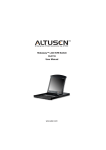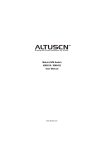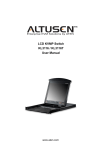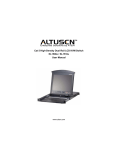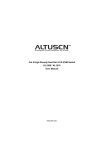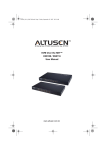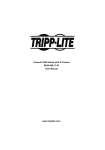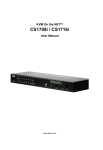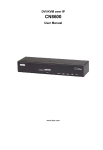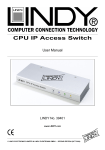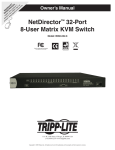Download Tripp Lite B014-000 User's Manual
Transcript
200507185 93-2464 B014-000 OM.qxd e Y nc NT ION cha uct! A R AT for a prod ty AR STR day Lite arran W I to pp /w G ine ri m RE nl E T .co o E ite R l er st a F ripp i g in .t e R w ww to w 3/27/2006 10:23 AM Page 1 Owner’s Manual Wireless Console Extender Model #: B014-000 Tripp Lite World Headquarters 1111 W. 35th Street, Chicago, IL 60609 USA (773) 869-1234, www.tripplite.com Copyright © 2006 Tripp Lite. All rights reserved. All trademarks are the property of their respective owners. The policy of Tripp Lite is one of continuous improvement. Specifications are subject to change without notice. 200507185 93-2464 B014-000 OM.qxd 3/27/2006 10:23 AM Page 2 Package Contents The complete B014-000 package contains the following components: • 1 B014-000 Wireless Console Extender • 1 Custom Keyboard/Mouse/Monitor Combo Cable • 1 Power Adapter • 1 CD with Software • 1 Owner’s Manual Note: Check to make sure that all the components are present and in good working order. If anything is missing, or was damaged in shipping, contact your dealer. Read this manual thoroughly and follow the installation and operation procedures carefully to prevent damage to the switch or any of the devices that connect to it. Table of Contents The Windows Client Starting Up ........................................15 Operation ..........................................16 OSD Control Panel ....................16 Keystrokes..................................17 Mouse Synchronization ............17 Hotkeys ......................................19 Configuring the Hotkeys............20 Video Adjustment ......................20 The Java Client Introduction........................................22 Operation ..........................................22 The Toolbar........................................23 The Log File ..............................................25 Appendix Specifications ....................................26 Rack Mounting ..................................26 Troubleshooting ................................27 General Operation......................27 Sun Systems ..............................27 The Windows Client ..................27 The Java Client ..........................28 Administrator Login Failure..............28 FCC Radio / TV Interference Notice ............29 Limited Warranty ......................................29 Warranty Registration ........................29 Glossary ....................................................30 Conventions ................................................3 Introduction Overview..............................................3 Features................................................4 System Requirements ..........................4 Hardware Setup Front View ..........................................5 Rear View ............................................5 Installation ..........................................6 Getting Started Wireless Connection ............................7 Logging In ..........................................7 Screen Elements ..................................8 Administration Introduction..........................................9 General ................................................9 Network ............................................10 Access Port ................................10 IP Address ..................................10 Log Server..................................11 Security ..............................................11 Filtering......................................12 User Manager ....................................13 Customization ....................................14 Firmware............................................15 2 200507185 93-2464 B014-000 OM.qxd 3/27/2006 10:23 AM Page 3 Conventions This manual uses the following conventions: [] Indicates keys to be pressed. For example, [Enter] means to press the Enter key. If keys need to be pressed simultaneously, they appear together in the same bracket with a plus sign between them: [Ctrl+Alt]. > Indicates selecting an option on a menu. For example, Start > Run means to open the Start menu, and then select Run. Indicates critical information. Introduction Overview The B014-000 uses the TCP/IP and IEEE 802.11b protocols to allow a user to remotely monitor and access computer/server installations wirelessly. It eliminates the expense of wired networks while providing the user the freedom to move around anywhere in the workplace. The user connects to the B014-000 via the unit's IP address. The B014-000 has advanced security features to ensure only authorized users can connect the B014-000. After a connection has been established and authorization granted, the remote computer can exchange keyboard, video and mouse signals with the attached server or KVM switch just as if they were physically present and working on the equipment directly. 3 200507185 93-2464 B014-000 OM.qxd 3/27/2006 10:23 AM Page 4 Introduction The Administrator and Client utilities make the unit installation, maintenance and operation easy. System administrators can handle a multitude of tasks with ease - from installing and running GUI applications, to BIOS level troubleshooting, routine monitoring, concurrent maintenance, system administration, rebooting and even pre-booting functions. The Administrator Utility is used to configure the system, limit access from remote computers, manage users and maintain the system with firmware and software module updates. The Log Server records all the events that take place on the B014-000 for the administrator to analyze. Both a Windows GUI Client and a Java Client are provided for IP connection and login to the unit from anywhere on the net. The client software allows the user to view and control the servers connected to the B014-000. The Java-based client ensures that the B014-000 is platform independent and is able to work with all operating systems. Once successfully connected and logged in, the user's screen displays whatever is running on the unit that is connected to the B014-000 (whether it is a KVM OSD display, a server's desktop or a running program). The user can then control the system from his console just as if he were there. Note: If you use more than one B014-000, the units must be at least 1000 ft. apart. Features • Wireless remote access of KVM switches or servers (IEEE 802.11b WLAN) • Advanced security features: password protection; advanced encryption technologies • High video resolution: up to 1600 x 1200 DDC2B • Windows GUI and Java based Client software; Java client works with all operating systems. • Firmware upgradeable via WLAN Ethernet connection. • Multiple user accounts System Requirements • It is recommended that the computers used to access the B014-000 have at least a P III 1 GHz processor and have the screen resolution set to 1024 x 768. • For the Windows Client, you require DirectX 7.0 or higher installed. • For the Java Client, you require Sun's Java 2 JRE 1.4 or higher. • Only non-interlaced video signals at the following resolutions and refresh rates are supported: Resolution Refresh Rates 640 x 480 720 x 400 800 x 600 1024 x 768 1152 x 864 1280 x 1024 1600 x 1200 60, 70, 56, 60, 60, 60, 60 70, 75 60, 70, 70, 70, 75, 85, 90, 100, 120 70, 75, 85, 90, 100, 120 75, 85, 90, 100 75, 85 75 4 200507185 93-2464 B014-000 OM.qxd 3/27/2006 10:23 AM Page 5 Hardware Setup Front View 1 2 3 4 5 6 1 Reset/FW: Pressing and holding this switch in while powering ON the B014-000 returns the unit to the factory default firmware level. After the B014-000 has been powered ON, pressing and holding this switch in for more than two seconds performs a system reset.* 2 Tx/Rx: This ORANGE LED indicates that the B014-000 is connected to a wired LAN (via the computer or KVM switch it is connected to). 3 Link LED: This LED flashes GREEN to indicate that a Client program has accessed the device. 4 Power LED: This LED illuminates when the B014-000 is powered up and ready to operate. 5 WLAN: This LED blinks ORANGE when a wireless station is connected to the B014-000 and is transmitting/receiving data. 6 WLAN Reset: Press and release this switch to perform a B014-000 reset. Press and hold for 10 seconds to reset the B014-000 to its WLAN factory default settings.* * Use thin object such as a paper clip to push this switch which is recessed in the case. Rear View 1 2 4 3 1 Antenna 2 KVM Port: The supplied cable links the B014-000 to the server or KVM switch plugs from here. 3 Local Console Port Section: The local administrator's keyboard, monitor, and mouse plug in here. The administrator can use this console to access the server (or KVM switch) connected to the B014-000. 4 Power Jack: The power adapter cable plugs in here. 5 200507185 93-2464 B014-000 OM.qxd 3/27/2006 10:23 AM Page 6 Hardware Setup Installation 1. Make sure that power to all the devices you will be connecting have been turned off. Disconnect the power cords of any computers that have the Keyboard Power On function. 2. Ensure that all devices on the installation are properly grounded. The following identifies the correct steps to be followed during installation (also see diagram below): 1 Plug the local administrator's keyboard, mouse and monitor into the Console Ports. 1. 2 Use the cable provided with this package to connect the B014-000's KVM Port to the 2. Keyboard, Video and Mouse ports of the server or KVM switch that you are installing. 3 Plug the power cord into the Power Socket in the unit and the adapter into a surge 3. suppressor. 4 Power up your server or KVM installation. 4. Note: If you are connecting to a KVM switch, power up your KVM installation according to the instructions that came with its Owner’s Manual. 3 2 1 6 200507185 93-2464 B014-000 OM.qxd 3/27/2006 10:23 AM Page 7 Getting Started Wireless Connection The B014-000 has a default IP address of 192.168.1.101 with a subnet mask of 255.255.255.0. Be sure to configure your computer's wireless card for a corresponding IP address. The valid address ranges are: 192.168.1.1 ~ 192.168.1.89; and 192.168.102 ~ 192.168.1.255 Note: Addresses 192.168.1.90 to 192.168.1.100 cannot be used as they are reserved for system diagnostics. Logging In The operation of the B014-000 is browser based. To begin, open your browser and specify the B014-000's IP address and web page name in the browser's URL location bar. For example: 192.168.1.101/test.htm Note: You must include a forward slash and the B014-000's web page name (in the example above, the web page name is test.htm). If you don't know the page name, get it from the B014-000 administrator. The B014-000 login page appears: Provide a valid Username and Password, then Click Login to continue. When you have successfully logged in, the Main Screen appears: 7 200507185 93-2464 B014-000 OM.qxd 3/27/2006 10:23 AM Page 8 Getting Started Note: 1. All screen displays in this manual are for example purposes. The actual may vary slightly in appearance and wording. 2. If you are the administrator logging in for first time, use the default Username: administrator; and the default Password: password. For security purposes, it is imperative that you remove these and set a unique Username and Password with the appropriate permissions (see User Manager, p. 13). 3. If an invalid login is entered, the following message will appear: Invalid Username or Password. Please try again. If message is displayed, attempt to log in again being careful to use the Username and Password. Screen Elements Except for the Logout icon, the icons arranged horizontally across the top of the page are the administration utilities. They are used to configure the B014-000 for operation. Your ability to make configuration changes depends on the permissions associated with your login information (see User Manager, p. 13). Note: Be sure to click the Logout icon when you end your session. The functions of each of the buttons in the bar are described in the table below: Icon Purpose Apply Saves without implementing any changes made in the administration dialog boxes (see the Administration chapter). The changes only go into effect when you enable Reset on exit (see p. 14 for details) and log out. Windows Client Allows users to connect to the B014-000 using Windows software, and to remotely control the connected server (or servers via a KVM switch). Java Client For platform independence, the Java Client allows users with Java installed to connect to the B014-000 and to remotely control the connected server (or servers via a KVM switch). Log All the events that take place on the B014-000 are recorded in a log file (see Network p. 10 for details). Clicking this icon displays the contents of the log file. 8 200507185 93-2464 B014-000 OM.qxd 3/27/2006 10:23 AM Page 9 Administration Introduction The administration utilities, represented by the icons located across the top of the B014-000 web page, are used to configure the B014-000 for operation. As you make your configuration changes, click the Apply button at the left of the web page to save the changes in the B014-000's configuration file. To have the changes actually take effect, you have to put a check in the Reset on Exit box (see Customization, p. 14), and log out. Note: 1. If you don't have Configuration privileges (see User Manager, p. 13), the Administration configuration dialogs are available for viewing only. All input fields are disabled, and cannot be changed. 2. All screen displays in this chapter are for example purposes. The actual screens that are displayed may vary slightly in appearance and wording. General The General panel displays three items of information about the B014-000's status. This is the same information that appears after you successfully log in from a browser: An explanation of each of the fields is given in the table below: Device Name To make it easier to manage installations with more than one B014-000, each can be given a name. To assign a name, key in one here (15 characters max.). MAC Address The B014-000's MAC Address displays here. Firmware Version Indicates the B014-000's current firmware version level. Note: New versions of the B014-000's firmware can be downloaded from our website as they become available, (see p. 14 for details). 9 200507185 93-2464 B014-000 OM.qxd 3/27/2006 10:23 AM Page 10 Administration Network The Network dialog is used to specify the B014-000's network environment. The page is divided into three panels: Access Port; IP Address; and Log Server. Access Port If a firewall is being used, the Administrator can specify the port numbers that the firewall will allow (and set the firewall accordingly). Users must specify the port number as part of the IP address when they log in to the B014-000. If an invalid port number (or no port number) is specified, the B014-000 will not be found. Note: If there is no firewall (on an Intranet, for example), it doesn't matter what these numbers are set to, since they have no effect. An explanation of the fields is given in the table below: Program This is the port number that must be specified when connecting from the Administrator and Windows Client software programs. Valid entries are from 1024 - 60,000. The default is 9000. Java This is the port number used for Java Client connections. Valid entries are from 0 - 65535. The default is 9002. IP Address The B014-000 uses a fixed IP Address. The default address is 192.168.1.101. You can however assign it a different address by keying a new address into the IP address field. The valid address ranges are: 192.168.1.1 ~ 192.168.1.89; and 192.168.102 ~ 192.168.1.255 Note: Addresses 192.168.1.90 to 192.168.1.100 cannot be used. They are reserved for system diagnostics. 10 200507185 93-2464 B014-000 OM.qxd 3/27/2006 10:23 AM Page 11 Administration Log Server: Important transactions that occur on the B014-000, such as logins and internal status messages, are kept in an automatically generated log file. Specify the MAC address and a Port number for the server you want the log server software to reside on. Security The Security page is used to control access to the B014-000. • IP and MAC Filters permit or deny access to the B014-000 for specific IP and MAC addresses attempting to access the system with B014-000 Client software. • The Web Page name lets the Administrator specify the web page that the user connects to when accessing the B014-000 with a browser. The user must include the name of this page in the IP address, or access will not be granted. For security purposes, we recommend that you periodically change the name of this page. Note: If a page is not specified, anyone will be able to access the B014-000 with the IP address alone … not a very secure situation at all. • The Admin Station Filters panel only works with the AP version of the B014-000 program. It is disabled in the browser version. 11 200507185 93-2464 B014-000 OM.qxd 3/27/2006 10:23 AM Page 12 Administration Filtering • There is a maximum of 100 filters allowed for each category (User IPs, User MACs, and Administrator MACs). • To enable IP filtering for User Stations, Click to put a check mark in the IP and/or MAC Filter enable checkbox. • To add a filter, Click Add. Dialog boxes similar to the ones below appear (the top example is for IP address filters; the bottom is for MAC address filters): • Specify the filter address in the dialog box, then Click OK. • Each IP filter can consist of a single address, or a range of addresses. For IP filtering, a second dialog box similar to the one below appears: To filter a single IP address, key in the same address as the start IP. To filter a continuous range of addresses, key in the end number of the range. • Click OK when done. • To delete a filter, select it and Click Remove. To modify a filter, select it and Click Edit. The Edit dialog box is similar to the Add dialog box. When it comes up, simply delete the old address and replace it with the new one. • User Station filtered items can be specified as included or excluded by highlighting the item and clicking the include or exclude radio button. – If the include button is checked, all the addresses within the filter range are allowed access to the B014-000; all other addresses are denied access. – If the exclude button is checked, all the addresses within the filter range are denied access to the B014-000; all other addresses are allowed access. • The Administrator station filter dialog boxes are similar to the MAC filter dialog boxes for user stations. 12 200507185 93-2464 B014-000 OM.qxd 3/27/2006 10:23 AM Page 13 Administration User Manager The User Manager dialog is used to manage user profiles. • A maximum of 64 user profiles can be created. • To add a user, fill in the information asked for in the User Info dialog box and Click Add. • To delete a user profile, select it and Click Remove. • To modify a user profile, select it; change the information shown in the User Info dialog box; and Click Update. • The Reset button clears all the information shown in the User Info dialog box. An explanation of the profile items is given in the table below: Username A minimum of 6 and a maximum of 15 characters are allowed. Password A minimum of 8 and a maximum of 15 characters are allowed. Confirm You are asked to enter the password twice to ensure that the intended pass word has been entered. The two entries must match. Description Use to store additional information about the user that you may wish to include. Permissions By default, all users may access the B014-000 via the Windows Client software. 1. Checking Configure gives a User administrator privileges, allowing him to set up and modify the B014-000's operating environment. 2. Checking Java client allows a User to access the B014-000 via the Java Client software. 13 200507185 93-2464 B014-000 OM.qxd 3/27/2006 10:23 AM Page 14 Administration Customization This configuration dialog allows the Administrator to set Timeout, Login failure, and Working mode parameters. An explanation of the Customization parameters is given in the table below: Time Out Control If the B014-000 is idle (doesn't receive any input from the computer that currently has access to it) for this specified amount of time, it ends the connection and becomes available for other users. Login Failure Login failures allowed, sets the number of consecutive failed login attempts permitted from a remote computer. Login failure timeout, sets the amount of time a remote computer must wait before attempting to login again after it has exceeded the number of allowed failures. Working Mode If Stealth Mode is enabled, the B014-000 cannot be pinged. If Echo Mode is enabled, the B014-000 will show up in the list of local B014-000 units when the AP version of the Administrator Utility is run. The B014-000 AP version is located on the CD that came with this package. Reset on Exit Placing a check here causes the B014-000 to reset itself and implement all the administration changes that you have made when you log out. Wait approximately 30 to 60 seconds before logging back in following the reset. 14 200507185 93-2464 B014-000 OM.qxd 3/27/2006 10:23 AM Page 15 Administration Firmware If new versions of the B014-000 firmware is available, it can be downloaded from our website. To upgrade the firmware, do the following: 1. After downloading the new firmware file to your computer, open the Firmware configuration dialog. 2. Click the Browse button; navigate to the directory that the new firmware file is in and select it. 3. Click Upload. 4. After the upload completes, enable the Reset on exit checkbox (see p. 14). 5. Click the Logout icon to exit and reset the B014-000. The Windows Client Starting Up To access the B014-000 with the Windows Client software: 1. After you log in, click the Windows Client icon at the left of the web page (see p. 7). Note: You must have DirectX 7.0 or higher installed on your computer. If not, the Client program will not load. 2. In the dialog box that comes up, click Open. Note: 1. If the browser cannot run the program, save it to disk, instead. Then, with your browser still open to the B014-000 web page, run the file from your disk. 2. If you use the save to disk method, for security purposes, you cannot simply run a previously downloaded version of the program. Each time you want to access the B014-000, you must log in to the web page with a valid username and password to download a fresh copy of the program. 3. When a connection to the B014-000 has been established, the following screen appears: 15 200507185 93-2464 B014-000 OM.qxd 3/27/2006 10:23 AM Page 16 The Windows Client Note: 1. If Full Screen Mode is enabled (there is a checkmark in the box), the remote display fills the entire screen of your local monitor. 2. If Full Screen Mode is not enabled (there is no checkmark in the box), the remote display appears as a window on your desktop. If the remote screen is too big to fit in the window, move the mouse pointer to the screen border that is closest to the area you want to view and the screen will scroll. 3. If Keep Screen Size is not enabled (there is no checkmark in the box), the remote screen is resized to fit the resolution of your local monitor. 4. If Keep Screen Size is enabled (there is a checkmark in the box), the remote screen is not resized. • If the remote resolution is smaller, its display appears like a window centered on your screen. • If the remote resolution is larger, its display is centered on your screen. To access the areas that are off screen, move the mouse to the corner of the screen that is closest to the area you want to view and the screen will scroll. 4. Click Switch to take over console control of the unit connected to the B014-000. Operation Once the Switch to the B014-000 has been accomplished, the remote system's video output is displayed on your monitor. At the same time, your local keystroke and mouse input is captured and sent to the remote system. OSD Control Panel A small OSD control panel showing the remote unit's video resolution and the B014-000's IP address opens at the lower right hand corner of the screen: The panel consists of an icon bar at the top, with two text bars below. Initially, the text bars display the video resolution and IP address of the device at the remote location. As the mouse pointer moves over the icons, the information in the text bars changes to describe the icon's function. The functions that the icons perform are described in the table below. 16 200507185 93-2464 B014-000 OM.qxd 3/27/2006 10:23 AM Page 17 The Windows Client Icon Function Drag the OSD display to another position on the screen by clicking and holding on the hand while you move the mouse. Click to bring up the Hotkey Setup dialog box (see p. 19 for details). Click to bring up the Video Adjustment dialog box (see p. 20 for details). Click to exit the Windows Client control of the remote unit. (Space) Hover over the space to see the video resolution and IP address of the device at the remote location. These LEDs show the Num Lock, Caps Lock, and Scroll Lock status of the remote computer. Click on the icon to toggle the status. Note: When you first connect, the LED display may not be accurate. To be sure, click on the LEDs to set them. Keystrokes Keyboard inputs do not affect the local computer except for [Alt + Tab] and [Ctrl + Alt + Del]. These two key sequences are retained on the local system to enable the use to switch among applications and to recover from disaster. In order to provide the [Alt + Tab] and [Ctrl + Alt + Del] functions on the remote system, one of the Function Keys must be used as a Substitute for the [Alt] key. For example, the F12 key could substitute for the Alt key, in which case [F12 + Tab] substitutes for [Alt + Tab]; and [Ctrl + F12 + Del] substitutes for [Ctrl + Alt + Del]. See Configuring the Hotkeys on p. 20 for details on setting up a substitute key. Note: While any Function Key can be used for the Substitute key, be sure you do not use one that is being used for another action. Mouse Synchronization While the B014-000 connection is open, mouse movements do not have any affect on your local system. Instead they are captured and sent to the remote system. The local mouse movement may periodically become out of synchronization with the remote system's mouse pointer, especially if you change video resolution. There are three quick methods that can be used to bring the two pointers back into sync: 1. Moving the mouse pointer over the Arrow in the OSD panel and right clicking 2. Moving the mouse pointer into the OSD panel and then moving it back out again 3. Performing an Auto Sync with the Video Adjustment function (see Video Adjustment, p. 20 for details). If performing the above does not resolve the problem, do the following: 1. Invoke the Adjust Mouse action with the Adjust Mouse hotkeys (see p. 20 for details). 2. Move the local mouse pointer exactly on top of the remote mouse pointer and Click. 17 200507185 93-2464 B014-000 OM.qxd 3/27/2006 10:23 AM Page 18 The Windows Client If these procedures still do not help, set the mouse speed and acceleration for the computer (or computers via KVM switch) connected to the B014-000 as follows: Windows2000: Set the mouse speed to the middle position; set the mouse acceleration to None (Control Panel Mouse Mouse Properties Motion): WindowsXP/Server2003: Set the mouse speed to the middle position; disable Enhance Pointer Precision (Control Panel Printers and Other Hardware Mouse Pointer Options): WinMe: Set the mouse speed to the middle position; disable mouse acceleration (click Advanced to get the dialog box for this). WinNT/Win98/Win95: Set the mouse speed to the slowest position. 18 200507185 93-2464 B014-000 OM.qxd 3/27/2006 10:23 AM Page 19 The Windows Client Hotkeys The Hotkey Setup Screen: Various configuration changes related to the keyboard, video, and mouse can be performed via hotkey combinations. The Hotkey setup utility is accessed by clicking the Keyboard icon on the OSD Control Panel. The actions performed by the Hotkeys are listed in the left column; the keys that invoke the actions are shown in the column to the right. An explanation of the actions is given in the table, below: Action Explanation Exit Remote Location Break the connection to the B014-000 and return to local operation. Adjust Video Bring up the video adjustment utility. Toggle OSD Toggles the OSD display Off and On. Toggle Mouse Display If you find the display of the two mouse pointers (local and remote) to be confusing or annoying, you can use this function to shrink the nonfunctioning pointer down to a barely-noticeable tiny circle - which can be ignored. Since this function is a toggle - use the hotkeys again to bring the mouse display back to its original configuration. Adjust Mouse Synchronizes the local and remote mouse movements following a video resolution change. Upon invoking this utility, click the local mouse pointer on top of the remote mouse pointer. Substitute Alt Key All keyboard inputs are captured and sent to the B014-000 except for [Alt + Tab] and [Ctrl + Alt + Del]. These work on your local computer. For these functions to work on a remote system, a function key must be substituted for the Alt key. If you decide to substitute the F12 key, you would use [F12 + Tab] and [Ctrl + F12 + Del]. Note: To invoke an action, you must press and release the keys one key at a time - do not chord the keys. 19 200507185 93-2464 B014-000 OM.qxd 3/27/2006 10:23 AM Page 20 The Windows Client Configuring the Hotkeys If you find the default Hotkey combinations inconvenient, you can configure them to any key sequence of your liking by doing the following: 1. Highlight the Action, then Click Start 2. Key in the Function keys (one at a time). The key names appear in the Key field as you press them. 3. When you have finished keying in your sequence, Click Stop 4. Click Set 5. Repeat for any other actions you wish to set up Note: You can use the same function keys for more than one action, as long as the first key is not the same. For example, you can use F1 F2 F3 for one action; F2 F1 F3 for another; F3 F2 F1 for a third, etc. Video Adjustment Adjust the placement and the picture quality of the remote screen (as displayed on your local monitor) with the Video Options function. Either click the Hammer icon on the OSD Control Panel, or use the Adjust Video hotkeys (see p. 20) to do so. The following screen appears: 20 200507185 93-2464 B014-000 OM.qxd 3/27/2006 10:23 AM Page 21 The Windows Client The meanings of the adjustment options are given in the table below: Option Usage Screen Position Adjust the horizontal and vertical position of the remote computer window by using the Arrow buttons. Auto-Sync Click Auto-Sync to have the function detect the vertical and horizontal offset values of the remote screen and automatically synchronize it with the local screen. If the local and remote mouse pointers are out of sync, performing this function will bring them back into sync (in most cases). Note: This function works best with a bright screen. If dissatisfied with the results, use the Screen Position arrows to position the remote display manually. RGB Drag the slider bars to adjust the RGB (Red, Green, Blue) values. When an RGB value is increased, the RGB component of the image is correspondingly increased. Video Quality Drag the slider bar to adjust the overall Video Quality. Values can be from 20 to 100. The larger the value, the clearer the picture and the more video data goes through the network. Depending on the network bandwidth, a high value may adversely effect response time. Bandwidth Control Adjusts the ratio between picture quality and network speed. For slow data connections, drag the slider bar to a lower setting to decrease the amount of video data transferred. This ensures screen refresh at workable speeds. 21 200507185 93-2464 B014-000 OM.qxd 3/27/2006 10:23 AM Page 22 The Java Client Introduction The Java Client makes the B014-000 accessible to all systems that have Java 2 installed. Java 2 is available for free download from Sun's Java web site (http://java.sun.com). To access the B014-000 with the Java Client software, perform the following: 1. After logging in (see p. 7), Click the Java Client icon. 2. In the dialog box, select Open. Note: If the browser won't open the Java Client program, save the program to disk and, with your browser still open, Launch it after the save. After a couple of seconds, an Authentication progress window appears: Upon successful completion of the authentication procedure, the remote system displays the following on your monitor: Operation You can work on the remote system using the screen display on your monitor as if it were your local system. 22 200507185 93-2464 B014-000 OM.qxd 3/27/2006 10:23 AM Page 23 The Java Client The Java Client's toolbar is hidden in the blank area at the bottom center of the screen. When you move the mouse pointer over this area, the toolbar appears: Note: 1. Switch between your local and remote programs using [Alt + Tab]. 2. There may be a slight delay before your keystrokes show up caused by net lag. You may also have to wait for the remote mouse to catch up to your local mouse before you click. 3. Some images such as motion images, may display poorly because of net lag, or insufficient computing power on the local machine. 4. If the local and remote mouse pointers get out of sync, use the Mouse Synchronization Button to bring them back into sync (see p. 24 for details). The Toolbar The Toolbar at the bottom of the screen is a Java applet that gives you control over the KVM operations. From left to right on the toolbar, the functions are as follows: Video: Clicking the first button brings up the Video Settings dialog box: Note: Perform an Autosync immediately after connecting to the B014-000 for improved mouse synchronization. 23 200507185 93-2464 B014-000 OM.qxd 3/27/2006 10:23 AM Page 24 The Java Client Keypad: Clicking the second button brings up the Keypad. The Keypad provides a one-click implementation on the remote system of select keystrokes that cannot be done directly from the keyboard. Mouse: The local mouse may periodically lose sync with the remote mouse movement. If performing an Autosync doesn't resolve the problem, the Mouse Synchronization function will resync the two. This is similar to the Mouse Synchronization feature of the Windows Client (see p. 17 for details). 1. Click the Mouse Synchronization button. The remote mouse pointer moves to the upper left area of the screen. 2. Move your local mouse pointer directly over the remote mouse pointer and Click. Lock LEDs: These LEDs show the Num Lock, Caps Lock, and Scroll Lock status of the remote computer. Click on the icon to toggle the status. Note: When you first connect, the LED display may not be accurate. To be sure, click on the LEDs to set them. The i Button: Clicking this button provides information about the Java Client. The ? Button: Clicking this button brings up the Java Client Help pages. Exit: Click this button to exit the Java Client program and return to local operation. 24 200507185 93-2464 B014-000 OM.qxd 3/27/2006 10:23 AM Page 25 The Log File The B014-000 logs all the events that take place on it, and writes them to a log file. This is stored as a searchable database. To view the contents of the log file, click the Log icon at the left of the web page. A screen similar to the one below appears: To clear the log file, click on the Clear Log icon at the lower right of the file. 25 200507185 93-2464 B014-000 OM.qxd 3/27/2006 10:23 AM Page 26 Appendix Specifications Function Specification Connectors Console Ports LEDs Video 1 x 6 pin mini-DIN F - Keyboard 1 x 6 pin mini-DIN F - Mouse 1 x HDB-15 F - Video KVM Port 1 x SPHD-15 F Power 1 x DC Jack (DC 5V; 2.6A max) Tx/Rx 1 (Amber) Link 1 (Green) Power 1 (Blue) WLAN 1 (Amber) Up to 1600 x 1200 @ 60 Hz Power Consumption 1800 mA Protocols IEEE 802.11b Environment Operating Temperature: 0 - 40° C, Storage Temperature: 0 - 60° C Humidity: 0 - 80% RH Housing Metal Weight 0.51kg Dimensions (L x W x H) 17 x 10 x 1.7 in Rack Mounting For convenience and flexibility, the B014-000 can be mounted on a system rack. To rack mount the unit do the following: 1 Screw the mounting bracket into the top or bottom of the unit as shown in the example 1. diagram below. 2 Screw the bracket into any convenient location on the rack. 2. 1 2 26 200507185 93-2464 B014-000 OM.qxd 3/27/2006 10:23 AM Page 27 Appendix Troubleshooting General Operation Problem Resolution Erratic Operation If the B014-000 is connected to a KVM switch, make sure to power on the switch before powering on the B014-000. Press and hold the WLAN Reset button (see p. 5), for 10 seconds. Sun Systems Problem Resolution Video display problems The display resolution should be set to 1024 x 768: with HDB15 interface systems (e.g., Sun Under Text Mode: Blade 1000 servers). 1. Go to OK mode and issue the following commands: setenv output-device screen:r1024x768x60 reset-all Under XWindow: 1. Open a console and issue the following command: m64config -res 1024x768x60 2. Log out 3. Log in Video display problems The display resolution should be set to 1024 x 768: with 13W3 interface systems (e.g., Sun Under Text Mode: Ultra servers). 1. Go to OK mode and issue the following commands: setenv output-device screen:r1024x768x60 reset-all Under XWindow: 1. Open a console and issue the following command: ffbconfig -res 1024x768x60 2. Log out 3. Log in The Windows Client Problem Resolution Remote mouse pointer is out of step. 1. Use the AutoSync feature (see Video Adjustment, p. 20), to synch the local and remote monitors. 2. If that doesn't resolve the problem, use the Adjust Mouse feature (see Mouse Movement, p. 17) to bring them back in step. Part of remote window is off my monitor. If Keep Screen Size (see p. 16) is not enabled, use the AutoSync feature (see Video Adjustment, p. 20), to synch the local and remote monitors. If it is enabled, see the discussion under Note on p. 16. The remote screen display is rotated 90° Enable Keep Screen Size. See the discussion under Note on p. 16 for details. I can't run Net Meeting when the Windows Client is running. Enable Keep Screen Size. See the discussion under Note on p. 16 for details. 27 200507185 93-2464 B014-000 OM.qxd 3/27/2006 10:23 AM Page 28 Appendix The Java Client For mouse synchronization problems, refer to the discussion on page 17. For connection and operation problems, see the table below: Symptom Action Java Client won't connect to the B014-000 1. Make sure to include the correct name of the web page when you specify the B014-000's IP address. 2. Close the Java Client, reopen it, and try again. Java Client performance deteriorates. Exit the program and start again. Administrator Login Failure If you are unable to perform an Administrator login (because the Username and Password information has become corrupted, or you have forgotten it), you can clear the login information with the following procedure: 1. Power off the B014-000 and remove its housing. 2. Short the jumper on the mainboard labeled J6. 3. Power on the switch. 4. When the front panel LEDs flash, power off the switch. 5. Remove the jumper cap from J6. 6. Close the housing and start the B014-000 back up. After you start back up, you can use the default Username and Password (see p. 8) to log in. 28 200507185 93-2464 B014-000 OM.qxd 3/27/2006 10:23 AM Page 29 FCC Radio / TV Interference Notice Note: This equipment has been tested and found to comply with the limits for a Class A digital device, pursuant to Part 15 of the FCC Rules. These limits are designed to provide reasonable protection against harmful interference when the equipment is operated in a commercial environment. This equipment generates, uses and can radiate radio frequency energy and, if not installed and used in accordance with the instruction manual, may cause harmful interference to radio communications. Operation of this equipment in a residential area is likely to cause harmful interference in which case the user will be required to correct the interference at his own expense. The user must use shielded cables and connectors with this product. Any changes or modifications to this product not expressly approved by the party responsible for compliance could void the user's authority to operate the equipment. Limited Warranty TRIPP LITE warrants its products to be free from defects in materials and workmanship for a period of one (1) year from the date of initial purchase. TRIPP LITE's obligation under this warranty is limited to repairing or replacing (at its sole option) any such defective products.To obtain service under this warranty, you must obtain a Returned Material Authorization (RMA) number from TRIPP LITE or an authorized TRIPP LITE service center. Products must be returned to TRIPP LITE or an authorized TRIPP LITE service center with transportation charges prepaid and must be accompanied by a brief description of the problem encountered and proof of date and place of purchase. This warranty does not apply to equipment which has been damaged by accident, negligence or misapplication or has been altered or modified in any way. EXCEPT AS PROVIDED HEREIN, TRIPP LITE MAKES NO WARRANTIES, EXPRESS OR IMPLIED, INCLUDING WARRANTIES OF MERCHANTABILITY AND FITNESS FOR A PARTICULAR PURPOSE. Some states do not permit limitation or exclusion of implied warranties; therefore, the aforesaid limitation(s) or exclusion(s) may not apply to the purchaser. EXCEPT AS PROVIDED ABOVE, IN NO EVENT WILL TRIPP LITE BE LIABLE FOR DIRECT, INDIRECT, SPECIAL, INCIDENTAL OR CONSEQUENTIAL DAMAGES ARISING OUT OF THE USE OF THIS PRODUCT, EVEN IF ADVISED OF THE POSSIBILITY OF SUCH DAMAGE. Specifically, TRIPP LITE is not liable for any costs, such as lost profits or revenue, loss of equipment, loss of use of equipment, loss of software, loss of data, costs of substitutes, claims by third parties, or otherwise. Warranty Registration Visit www.tripplite.com/warranty today to register the warranty for your new Tripp Lite product. You'll be automatically entered into a drawing for a chance to win a FREE Tripp Lite product!* * No purchase necessary. Void where prohibited. Some restrictions apply. See website for details. 29 200507185 93-2464 B014-000 OM.qxd 3/27/2006 10:23 AM Page 30 Glossary L Log File......................................................25 Main Screen ......................................25 Log Server....................................................4 Login Failure ................................................14 Invalid login ......................................28 Login Page ..................................................7 M MAC Address ..............................................9 Main Screen ................................................8 Mouse Synchronization ............................17 N Network Environment................................10 O OSD ..........................................................16 Overview......................................................3 R Rack Mounting ..........................................26 Rear Panel Components ..............................5 Reset On Exit ............................................14 S Substitute Keys ..........................................17 System Requirements ..................................4 T Time Out Control ......................................14 Troubleshooting Java Client ........................................28 Windows Client ................................27 U Upgrading the Firmware............................15 User Manager ............................................13 V Video Adjustment Java Client ........................................23 Windows Client ................................20 W Windows Client ........................................15 Hotkeys ..............................................19 Starting Up ........................................15 Troubleshooting ................................27 A Administration ............................................9 General Page........................................9 Network Page ....................................10 Security Page ....................................11 Administrator Login Failure ......................28 Administrator Utility Customization page ..........................14 Autosync ....................................................23 C Components Rear panel ............................................5 Corrupt Password ......................................28 F Features ........................................................4 Filtering......................................................12 Firmware Upgrading ..........................................15 Forgotten Password....................................28 G Getting Started ............................................7 H Hardware Setup............................................5 Hotkey Setup Screen..................................19 Hotkeys Windows Client ................................19 I Installation....................................................6 Invalid Login..............................................28 J Java Client..................................................22 Keypad ..............................................24 Operation ..........................................22 Toolbar ..............................................23 Troubleshooting ................................28 30 200507185 93-2464 B014-000 OM.qxd 3/27/2006 10:23 AM Page 31 The policy of TRIPP LITE is one of continuous improvement. Specifications are subject to change without notice. This product designed and engineered in the USA. 31 200507185 93-2464 B014-000 OM.qxd 3/27/2006 10:23 AM Page 32 Tripp Lite World Headquarters 1111 W. 35th Street, Chicago, IL 60609 USA (773) 869-1234, www.tripplite.com 200507185 93-2464
































